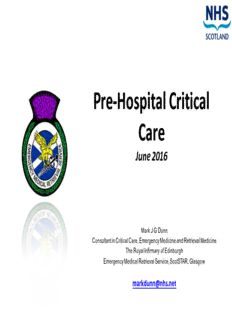
Mark Dunn, Prehospital Critical Care PDF
Preview Mark Dunn, Prehospital Critical Care
Pre-Hospital Critical Care June 2016 Mark J G Dunn Consultant in Critical Care, Emergency Medicine and Retrieval Medicine The Royal Infirmary of Edinburgh Emergency Medical Retrieval Service, ScotSTAR, Glasgow [email protected] Aims • What happens now? • Pre-Hospital trauma care – the scary truth • What is the evidence? • Human Factors - again! SAS What can they do? • Paramedic – Not Ambulance care assistant – Not driver – Not Ambulance technician What can they do? • C – Pressure dressing • A – O 2 – C-spine collar, blocks and tape – Adjuncts – 1st and 2nd Gen SGDs – Intubate the cardiac arrest patient – Needle cric • B – BVM – Needle thoracocentesis • C – IV cannulae – IO access (on some vehicles PRU, SORT) – IV crystalloid – TXA - coming very soon – Pelvic binder – Splints • D – Analgesia (Morphine, Entonox) – Spinal immobilisation • E – Packaging (scoop stretcher, blankets) What can they do? • C – Pressure dressing • A – O 2 – C-spine collar, blocks and tape – Adjuncts – 2nd Gen SGDs – Intubate the cardiac arrest patient – Needle cric • B – BVM – Needle thoracocentesis • C – IV cannulae – IO access (on some vehicles) – IV crystalloid – TXA - coming very soon – Pelvic binder – Splints • D – Analgesia (Morphine, Entonox) – Spinal immobilisation • E – Packaging (scoop stretcher, blankets) What can the team do? • C – CAT, military style pressure dressings, haemostatic agents • A – O 2 – C-spine collar, blocks and tape – Adjuncts – 1st and 2nd Gen SGDs – Intubate the cardiac arrest patient – Needle cric • B – BVM – Needle thoracocentesis • C – IV cannulae – IO access (on some vehicles) – IV crystalloid – TXA - coming very soon – Pelvic binder – Splints • D – Analgesia (Morphine, Entonox) – Spinal immobilisation • E – Packaging (scoop stretcher, blankets)
Description: